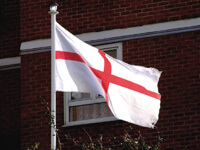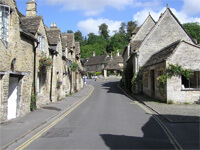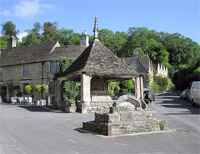| Sources (hover for more info) |
| Civil Registration |
| Census |
| Poor Law Records |
Locations
It is essential to not only locate the correct places and surrounding area with which ancestors were associated, but also the jurisdictions to which those places belonged. Jurisdictions are responsible for the creation of records as well as how and where they are filed. The two major jurisdictions for English research are the civil government and the state church, the Church of England. The levels of civil government (in their descending order of size) are: county and borough, hundred (wapentake in the North), and civil parish or township. The civil parish and church parish in the South usually share the same boundaries and name.
 Start with the England and Wales Jurisdictions 1851 map online at FamilySearch Maps. Type in the parish or place name. When the county map comes up with a pin number, click on the pin to see an Information bubble. Then click on the Jurisdiction label at the top of the bubble to find the names of the county, hundred, and church jurisdictions. The Options label will allow you to see the parishes that border your place, list the parishes within a radius up to 20 miles, or give what is available for your place in the FHL catalog. For further details about all of the jurisdictions, including abbreviations for the counties, go here.
Start with the England and Wales Jurisdictions 1851 map online at FamilySearch Maps. Type in the parish or place name. When the county map comes up with a pin number, click on the pin to see an Information bubble. Then click on the Jurisdiction label at the top of the bubble to find the names of the county, hundred, and church jurisdictions. The Options label will allow you to see the parishes that border your place, list the parishes within a radius up to 20 miles, or give what is available for your place in the FHL catalog. For further details about all of the jurisdictions, including abbreviations for the counties, go here.
An historic or traditional county is one in existence before 1974. For general research in the FHL concerning such counties, their history and places, see the county table. The definition of an ancient parish employed by this website is a church parish in existence before 1813. At that time there were between 10,000-11,000 parishes. The higher church jurisdictions over the parish are outlined in the church table.
Finding Church Parishes in a Given Radius
 In addition to the England and Wales Jurisdictions 1851 map described above, consider using the Parish Locator also known as the GENUKI Church Database as of 1837. Enter the place name and county and press the search button. The resulting list shows parishes and may indicate nonconformist churches within 3 miles of that place. At the top of the page you can change the default setting of 3 in the Distance field to any number and search again. The recommended radius for parish research is 10 miles.
In addition to the England and Wales Jurisdictions 1851 map described above, consider using the Parish Locator also known as the GENUKI Church Database as of 1837. Enter the place name and county and press the search button. The resulting list shows parishes and may indicate nonconformist churches within 3 miles of that place. At the top of the page you can change the default setting of 3 in the Distance field to any number and search again. The recommended radius for parish research is 10 miles.
Eventually, the Parish Locator will be a thorough guide to a place and its records. It already provides information on smaller places that do not have a church and can be a useful guide to graveyards in the area. Clicking on the underlined items in the parish list may lead to a wealth of information online taken from old maps, directories, gazetteers and church histories.
Geographic Reference Tools
These tools are meant for those who would like to dig deeper or do not have easy access to the Internet. For a word description of a place and the jurisdictions to which it belongs, start by checking your place in at least numbers 1 and 4 below.
- John Marius Wilson's Imperial Gazetteer of England and Wales, 1866-1872. It was published in 6 sections: sections 1-4 from 1866-1869, 5 in 1870 and 6 in 1872. The entire work was also published in 1872 in 2 volumes of some 1200 pages each. The FHL has the 6 sections under Ref 942 E5i and BYU has the 2 volumes under Map Collection DA640 .W555x 1872. Wilson's is the basis for the FHL catalog. This gazetteer gives for each parish its hundred, diocese, and post-1851 civil registration district. If not stated, the population figures refer to the 1861 census. Wilson's 1870 Imperial Gazetteer is free online here and the following two sites:
- A Vision of Britain Through Time has great potential for all kinds of 19th century studies. It is based on the population tables of the censuses; Frederic A. Youngs' Guide to the Local Administrative Units of England, 1979 and 1991; and two 19th century gazetteers: John Bartholomew's Gazetteer of the British Isles, 1887 and John Wilson's Imperial Gazetteer outlined above. Select "Search Places." If there is no entry from the Imperial Gazetteer or you would like to search the entire gazetteer, go to the next site.
- The Imperial Gazetteer from the 2 volume edition of 1872 has been scanned and is available on Ancestry.com. This is a subscription site but you have free access to it at the FHL, BYU, and a FamilySearch account through Partner Access. It is also available on FamilySearch Books.
- Samuel Lewis' Topographical Dictionary of England, 1831.
 This 4 volume set provides information on the parishes before the changes made by the railroad boom of the 1840s. It gives the hundred, archdeaconry, and diocese, but is not very useful for finding places smaller than the parish. Look for it at the FHL under Ref 942 E5l and at BYU under RELIGION/FAMILY HISTORY REF DA625 .L67. Different editions are available online on Google Books, Ancestry.com, and FamilySearch Books. Note the statement about free access in the preceding paragraph.
This 4 volume set provides information on the parishes before the changes made by the railroad boom of the 1840s. It gives the hundred, archdeaconry, and diocese, but is not very useful for finding places smaller than the parish. Look for it at the FHL under Ref 942 E5l and at BYU under RELIGION/FAMILY HISTORY REF DA625 .L67. Different editions are available online on Google Books, Ancestry.com, and FamilySearch Books. Note the statement about free access in the preceding paragraph. - John Adams' Index Villaris, 1690. This work can be use to compare the jurisdictions in the 19th century with the late 17th century. It also adds the rural deaneries at that time which may differ from those in England Jurisdictions 1851. It will be found at the FHL under Q 942 E5ad. A scanned version is also available at BYU through the URL connection in their catalog entry.
- Cecil R. Humphery-Smith's Phillimore Atlas and Index of Parish Registers, 3rd ed., 2003. Check the index in the back arranged by county and parish for coordinates to the county map in front showing the parish boundaries and the year the parish began keeping records. The index includes such information as where the parish registers will be found and for what years, the pre-1852 civil registration districts, and the whereabouts of marriage indexes. The FHL has it under Ref 942 E7pa 2003. This edition is at BYU under G 1816 .E42 P5x 2003. This is also available on Ancestry.com.
Tiny Places, Altered Place-Names, and Phonetic Forms
If you have not found your place in any of the above references, then dig deeper in the following:
- For the volumes of the English Place-Name Society, see the county table.
- For phonetic problems consult Robert C. Hope's Glossary of Dialectal Place-Nomenclature, 1883 & reprint 1968. The FHL copy is under Ref 942 E2g and at BYU it is DA640 .H6 1883a. It also provides pronunciations for some surnames and is now online here. This is also available on FamilySearch Books.
- Conduct a study of the maps available for the time period and area of interest.